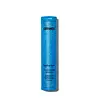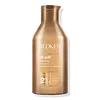What's inside
What's inside
 Key Ingredients
Key Ingredients

 Benefits
Benefits

 Concerns
Concerns

 Ingredients Side-by-side
Ingredients Side-by-side

Water
Skin ConditioningSodium Cocoyl Isethionate
CleansingCocamidopropyl Hydroxysultaine
CleansingCoco-Glucoside
CleansingGlycol Distearate
EmollientSqualane
EmollientHippophae Rhamnoides Fruit/Seed Oil
AntimicrobialBrassica Campestris Seed Oil
Skin ConditioningSesamum Indicum Seed Oil
EmollientCocos Nucifera Oil
MaskingSodium Hyaluronate
HumectantPolyglutamic Acid
Skin ConditioningSpirulina Platensis Extract
Skin ProtectingCocos Nucifera Water
MaskingEmblica Officinalis Fruit Extract
Skin ConditioningCurcuma Longa Root Extract
MaskingLeuconostoc/Radish Root Ferment Filtrate
AntimicrobialCocamide Mipa
EmulsifyingCoconut Acid
CleansingPolyester-11
Skin ConditioningGuar Hydroxypropyltrimonium Chloride
Skin ConditioningPolyquaternium-7
Polyquaternium-73
Sodium Methyl Cocoyl Taurate
CleansingTetrasodium Glutamate Diacetate
Sodium Benzoate
MaskingSodium Isethionate
CleansingSodium Hydroxide
BufferingSodium Chloride
MaskingCitric Acid
BufferingPotassium Sorbate
PreservativePhenoxyethanol
PreservativeParfum
MaskingBenzyl Benzoate
AntimicrobialHydroxycitronellal
PerfumingLimonene
PerfumingWater, Sodium Cocoyl Isethionate, Cocamidopropyl Hydroxysultaine, Coco-Glucoside, Glycol Distearate, Squalane, Hippophae Rhamnoides Fruit/Seed Oil, Brassica Campestris Seed Oil, Sesamum Indicum Seed Oil, Cocos Nucifera Oil, Sodium Hyaluronate, Polyglutamic Acid, Spirulina Platensis Extract, Cocos Nucifera Water, Emblica Officinalis Fruit Extract, Curcuma Longa Root Extract, Leuconostoc/Radish Root Ferment Filtrate, Cocamide Mipa, Coconut Acid, Polyester-11, Guar Hydroxypropyltrimonium Chloride, Polyquaternium-7, Polyquaternium-73, Sodium Methyl Cocoyl Taurate, Tetrasodium Glutamate Diacetate, Sodium Benzoate, Sodium Isethionate, Sodium Hydroxide, Sodium Chloride, Citric Acid, Potassium Sorbate, Phenoxyethanol, Parfum, Benzyl Benzoate, Hydroxycitronellal, Limonene
Water
Skin ConditioningSodium Laureth Sulfate
CleansingSodium Chloride
MaskingCocamidopropyl Betaine
CleansingDimethicone
EmollientParfum
MaskingSodium Benzoate
MaskingAmodimethicone
Carbomer
Emulsion StabilisingGlycerin
HumectantGuar Hydroxypropyltrimonium Chloride
Skin ConditioningTrideceth-10
CleansingSalicylic Acid
MaskingHexylene Glycol
EmulsifyingGlycol Distearate
EmollientCitric Acid
BufferingMica
Cosmetic ColorantSodium Cocoyl Amino Acids
CleansingPEG-100 Stearate
Phenoxyethanol
PreservativeSteareth-6
EmulsifyingTrideceth-3
EmulsifyingPotassium Dimethicone PEG-7 Panthenyl Phosphate
Skin ConditioningCI 77891
Cosmetic ColorantSodium Sarcosinate
Benzyl Alcohol
PerfumingPropylene Glycol
HumectantCoumarin
PerfumingLinalool
PerfumingPEG-45m
HumectantBenzyl Benzoate
AntimicrobialHexyl Cinnamal
PerfumingLimonene
PerfumingAloe Barbadensis Leaf Juice Powder
Skin ConditioningArginine
MaskingHydrolyzed Soy Protein
HumectantPlukenetia Volubilis Seed Oil
EmollientCaramel
Cosmetic ColorantAcetic Acid
BufferingFumaric Acid
BufferingHydrolyzed Vegetable Protein Pg-Propyl Silanetriol
Skin ConditioningCereus Grandiflorus Flower Extract
Skin ConditioningGlucose
HumectantLactic Acid
BufferingPotassium Sorbate
PreservativeTetrasodium EDTA
BHT
AntioxidantTocopherol
AntioxidantSodium Hydroxide
BufferingWater, Sodium Laureth Sulfate, Sodium Chloride, Cocamidopropyl Betaine, Dimethicone, Parfum, Sodium Benzoate, Amodimethicone, Carbomer, Glycerin, Guar Hydroxypropyltrimonium Chloride, Trideceth-10, Salicylic Acid, Hexylene Glycol, Glycol Distearate, Citric Acid, Mica, Sodium Cocoyl Amino Acids, PEG-100 Stearate, Phenoxyethanol, Steareth-6, Trideceth-3, Potassium Dimethicone PEG-7 Panthenyl Phosphate, CI 77891, Sodium Sarcosinate, Benzyl Alcohol, Propylene Glycol, Coumarin, Linalool, PEG-45m, Benzyl Benzoate, Hexyl Cinnamal, Limonene, Aloe Barbadensis Leaf Juice Powder, Arginine, Hydrolyzed Soy Protein, Plukenetia Volubilis Seed Oil, Caramel, Acetic Acid, Fumaric Acid, Hydrolyzed Vegetable Protein Pg-Propyl Silanetriol, Cereus Grandiflorus Flower Extract, Glucose, Lactic Acid, Potassium Sorbate, Tetrasodium EDTA, BHT, Tocopherol, Sodium Hydroxide
 Reviews
Reviews

Ingredients Explained
These ingredients are found in both products.
Ingredients higher up in an ingredient list are typically present in a larger amount.
Benzyl Benzoate is usually created from the condensation of benzoic acid and benzyl alcohol. It is used as a preservative, solvent, and has a floral/balsamic scent in large amounts.
As a preservative, Benzyl Benzoate works against bacteria and fungus. It is often used to treat scabies and lice in medicine.
Solvents are used to keep ingredients together in a product. They can help dissolve ingredients to stable bases or help evenly distribute ingredients throughout the product.
Due to its fragrance, Benzyl Benzoate can be sensitizing and may cause contact dermatitis. It is a known EU allergen. We recommend speaking with a professional if you have any concerns.
Benzyl Benzoate can be naturally found in cranberries and peaches.
Learn more about Benzyl BenzoateCitric Acid is an alpha hydroxy acid (AHA) naturally found in citrus fruits like oranges, lemons, and limes.
Like other AHAs, citric acid can exfoliate skin by breaking down the bonds that hold dead skin cells together. This helps reveal smoother and brighter skin underneath.
However, this exfoliating effect only happens at high concentrations (20%) which can be hard to find in cosmetic products.
Due to this, citric acid is usually included in small amounts as a pH adjuster. This helps keep products slightly more acidic and compatible with skin's natural pH.
In skincare formulas, citric acid can:
While it can provide some skin benefits, research shows lactic acid and glycolic acid are generally more effective and less irritating exfoliants.
Most citric acid used in skincare today is made by fermenting sugars (usually from molasses). This synthetic version is identical to the natural citrus form but easier to stabilize and use in formulations.
Read more about some other popular AHA's here:
Learn more about Citric AcidGlycol Distearate serves as a pearlizing or opacifying agent in cosmetic products.
It's often included in cleansers and haircare products to give them a lustrous or shimmering appearance.
It is derived from stearic acid, a natural fatty acid commonly found in vegetable oils and animal fats.
Glycol Distearate isn't fungal acne safe.
Learn more about Glycol DistearateThis ingredient is derived from guar gum.
It is a conditioning ingredient, meaning it helps soften skin and hair.
Limonene is a fragrance that adds scent and taste to a formulation.
It's found in the peel oil of citrus fruits and other plants such as lavender and eucalyptus. The scent of limonene is generally described as "sweet citrus".
Limonene acts as an antioxidant, meaning it helps neutralize free radicals.
When exposed to air, oxidized limonene may sensitize the skin. Because of this, limonene is often avoided by people with sensitive skin.
The term 'fragrance' is not regulated in many countries. In many cases, it is up to the brand to define this term. For instance, many brands choose to label themselves as "fragrance-free" because they are not using synthetic fragrances. However, their products may still contain ingredients such as essential oils that are considered a fragrance.
Learn more about LimoneneParfum is a catch-all term for an ingredient or more that is used to give a scent to products.
Also called "fragrance", this ingredient can be a blend of hundreds of chemicals or plant oils. This means every product with "fragrance" or "parfum" in the ingredients list is a different mixture.
For instance, Habanolide is a proprietary trade name for a specific aroma chemical. When used as a fragrance ingredient in cosmetics, most aroma chemicals fall under the broad labeling category of “FRAGRANCE” or “PARFUM” according to EU and US regulations.
The term 'parfum' or 'fragrance' is not regulated in many countries. In many cases, it is up to the brand to define this term.
For instance, many brands choose to label themselves as "fragrance-free" because they are not using synthetic fragrances. However, their products may still contain ingredients such as essential oils that are considered a fragrance by INCI standards.
One example is Calendula flower extract. Calendula is an essential oil that still imparts a scent or 'fragrance'.
Depending on the blend, the ingredients in the mixture can cause allergies and sensitivities on the skin. Some ingredients that are known EU allergens include linalool and citronellol.
Parfum can also be used to mask or cover an unpleasant scent.
The bottom line is: not all fragrances/parfum/ingredients are created equally. If you are worried about fragrances, we recommend taking a closer look at an ingredient. And of course, we always recommend speaking with a professional.
Learn more about ParfumPhenoxyethanol is a preservative that has germicide, antimicrobial, and aromatic properties. Studies show that phenoxyethanol can prevent microbial growth. By itself, it has a scent that is similar to that of a rose.
It's often used in formulations along with Caprylyl Glycol to preserve the shelf life of products.
Potassium Sorbate is a preservative used to prevent yeast and mold in products. It is commonly found in both cosmetic and food products.
This ingredient comes from potassium salt derived from sorbic acid. Sorbic acid is a natural antibiotic and effective against fungus.
Both potassium sorbate and sorbic acid can be found in baked goods, cheeses, dried meats, dried fruit, ice cream, pickles, wine, yogurt, and more.
You'll often find this ingredient used with other preservatives.
Learn more about Potassium SorbateSodium Benzoate is a preservative. It's used in both cosmetic and food products to inhibit the growth of mold and bacteria. It is typically produced synthetically.
Both the US FDA and EU Health Committee have approved the use of sodium benzoate. In the US, levels of 0.1% (of the total product) are allowed.
Sodium benzoate works as a preservative by inhibiting the growth of bacteria inside of cells. It prevents the cell from fermenting a type of sugar using an enzyme called phosphofructokinase.
It is the salt of benzoic acid. Foods containing sodium benzoate include soda, salad dressings, condiments, fruit juices, wines, and snack foods.
Studies for using ascorbic acid and sodium benzoate in cosmetics are lacking, especially in skincare routines with multiple steps.
We always recommend speaking with a professional, such as a dermatologist, if you have any concerns.
Learn more about Sodium BenzoateChances are, you eat sodium chloride every day. Sodium Chloride is also known as table salt.
This ingredient has many purposes in skincare: thickener, emulsifier, and exfoliator.
You'll most likely find this ingredient in cleansers where it is used to create a gel-like texture. As an emulsifier, it also prevents ingredients from separating.
There is much debate on whether this ingredient is comedogenic. The short answer - comedogenic ratings don't tell the whole story. Learn more about comegodenic ratings here.
The concensus about this ingredient causing acne seems to be divided. Research is needed to understand if this ingredient does cause acne.
Scrubs may use salt as the primary exfoliating ingredient.
Learn more about Sodium ChlorideSodium Hydroxide is also known as lye or caustic soda. It is used to adjust the pH of products; many ingredients require a specific pH to be effective.
In small amounts, sodium hydroxide is considered safe to use. However, large amounts may cause chemical burns due to its high alkaline.
Your skin has a natural pH and acid mantle. This acid mantle helps prevent harmful bacteria from breaking through. The acid mantle also helps keep your skin hydrated.
"Alkaline" refers to a high pH level. A low pH level would be considered acidic.
Learn more about Sodium HydroxideWater. It's the most common cosmetic ingredient of all. You'll usually see it at the top of ingredient lists, meaning that it makes up the largest part of the product.
So why is it so popular? Water most often acts as a solvent - this means that it helps dissolve other ingredients into the formulation.
You'll also recognize water as that liquid we all need to stay alive. If you see this, drink a glass of water. Stay hydrated!
Learn more about Water